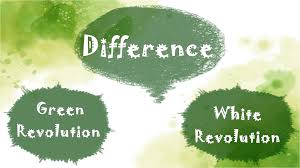What is the difference between the green and white revolution?
Green and white revolutions are about human history where agricultural technology help to increase the level of production. But these revolutions are slightly different.
The main difference between the green and white revolution is that the former is a program started in India with an intention of increasing wheat and rice production whereas the latter is associated with the objective of increasing milk production in India.
You May Also Like: Difference between Cereals and Pulses

Comparison Table (Green Vs White Revolution)
| Basic Terms | Green Revolution | White Revolution |
| Meaning | It is a human history where advancement in agricultural technology foster increase in production in global agriculture | It is a rural development program that enhances the increase in dairy products |
| Period of Time | It began around the 1940s and 1960s | It started in the 1970s |
| Scope | Global project | Indian Project |
| Nature | Focuses on agricultural projects for global scale | Focuses on dairy products |
| Founded by | Dr. M.S. Swaminathan in India and Norman Borlaug worldwide. | Verghese Kurien |
| Significance | Introduction of a high yielding variety of seeds to increase crop production in developing countries | Aim to increase the production of milk and its products in Indian Market. It also focuses to make India self-sufficient in the sector |
| Duration | 1967-1978. | Phase I – 1970-1980.
Phase II – 1981-1985. Phase – III – 1985-1996. |
What Is Green Revolution?
The green revolution was developed to increase the production of food grains such as wheat and rice. The program started in the 1940s and 1960s. It was spearheaded by Norman Borlaug who is the Father of the Green Revolution.
The program results in high yielding new varieties of crops in India and other developing countries. The project was given much focus in India after independence to spearhead food security.
The project is not only applicable in India but also in other developing countries. The revolution has helped the government economy and also the creation of jobs.
The use of chemical fertilizer and pesticides is detrimental to the environment. It has increases pollution and destruction of soil fertility.
What Is White Revolution?
The white revolution was also known as operation flood. It is a rural development project that began in India with the aim of increasing milk production.
The main purpose of the program was to make India the largest producer of milk and its product in the world. The program created a good connection between farmers and consumers.
You May Also Like: Difference between Hydroponics and Aquaponics
Main Difference between Green and White Revolution
- The green revolution increases the production of food grains like rice and wheat whereas the white revolution focuses on increasing milk production and its products in India.
- Norman Borlaug is the Father of the Green Revolution and Verghese Kurien is the Father of the White Revolution.
- Green Revolution was established in 1965 whereas the white revolution was established in 1970.
- The main purpose of the Green Revolution was to foster high-yielding seeds to increase crop production while White Revolution initiate an increase in milk production and its products.
- The duration of the Green Revolution was 1967-1978 but that the white revolution occurs in three phases.
In Conclusion
Both the green and white revolution brought a lot of changes in the agricultural field. Developing countries have grown economically due to an increase in agricultural-related job opportunities. Family living in rural areas have better lifestyles when compared in the past.
More Sources and References
- https://www.nationalgeographic.com/foodfeatures/green-revolution/
- https://www.britannica.com/event/green-revolution
- https://en.wikipedia.org/wiki/Green_Revolution